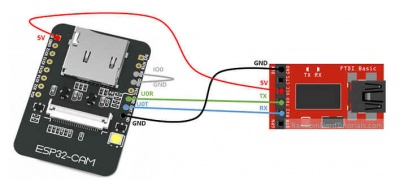Zigbee
From Eric
m |
m |
||
| Line 3: | Line 3: | ||
In order to take benefits from all the features of Home Assistant on a RPi 4 (in particular, the add-ons), the best solution is to install HASSIO. | In order to take benefits from all the features of Home Assistant on a RPi 4 (in particular, the add-ons), the best solution is to install HASSIO. | ||
| - | To communicate with the RPi after installation, the simplest solution is to connect it to your ethernet network using a cable. Then, you install the SSH and Web terminal add-on from the community repo. And then you can use the nmcli utility to setup your WiFi connection. Some explanations are given | + | To communicate with the RPi after installation, the simplest solution is to connect it to your ethernet network using a cable. Then, you install the SSH and Web terminal add-on from the community repo. And then you can use the nmcli utility to setup your WiFi connection. Some explanations are given [https://community.home-assistant.io/t/guide-connecting-pi-with-home-assistant-os-to-wifi-or-other-networking-changes/98768 here]: |
| - | + | $ nmcli wifi rescan | |
| + | $ nmcli device wifi | ||
| + | $ nmcli device wifi connect "YOUR_SSID" password "YOUR_WIFI_PASSWORD" | ||
Revision as of 16:11, 16 August 2021
Contents |
Install Home Assistant
In order to take benefits from all the features of Home Assistant on a RPi 4 (in particular, the add-ons), the best solution is to install HASSIO.
To communicate with the RPi after installation, the simplest solution is to connect it to your ethernet network using a cable. Then, you install the SSH and Web terminal add-on from the community repo. And then you can use the nmcli utility to setup your WiFi connection. Some explanations are given here:
$ nmcli wifi rescan $ nmcli device wifi $ nmcli device wifi connect "YOUR_SSID" password "YOUR_WIFI_PASSWORD"
Install zigbee2mqtt
Configure the zigbee adapter
See https://www.zigbee2mqtt.io/information/flashing_the_cc2531.html
Install zigbee2mqtt
See https://www.zigbee2mqtt.io/
To mofidy the state of a device, refer to the zigbee2mqtt documentation for your device. For instance, for a 4-relay Tuya adapter:
mosquitto_pub -t "zigbee2mqtt/relays/set" -m '{"state_l1": "OFF"}'
start zigbee2mqtt automatically
See https://www.zigbee2mqtt.io/getting_started/running_zigbee2mqtt.html
# Stopping Zigbee2MQTT sudo systemctl stop zigbee2mqtt
# Starting Zigbee2MQTT sudo systemctl start zigbee2mqtt
# View the log of Zigbee2MQTT sudo journalctl -u zigbee2mqtt.service -f
Zigbee sniffing
Install
- Texas Instruments SmartRF studio (I use smartrftm_studio-2.21.0)
- Texas instruments flash programmer (I use flash-programmer-1.12.8)
- Zboss (I use 2020_11_02_zboss_sniffer_windows_ubuntu_64bit)
- WireShark
The Zboss archive contains both the desktop application and the firmware to be programmed to the dongle.
Note that I have not managed to make ZBoss work on Linux.
On Linux, you’ll have to use cc-tools:
git clone https://github.com/dashesy/cc-tool.git cd cc-tool ./bootstrap ./configure make
And to flash:
sudo ./cc-tool -e -w <firmware>.hex
Instructions are given at https://www.zigbee2mqtt.io/how_tos/how_to_sniff_zigbee_traffic.html
(see also: https://www.hal9k.dk/sniffing-philips-hue-zigbee-traffic-with-wireshark/, https://www.youtube.com/watch?v=4vG4CVNAm_A,
Zigbee frames are encrypted.
To decrypt the frames, follow the following procedure:
https://electronics.stackexchange.com/questions/158637/zigbee-firmware-for-cc2530-chips
Install an ESP32 CAM camera
To install an ePS32 CAM, the easiest way is to use the ESPhome firmware generator.
Installing ESPhome (e.g, on the Raspberry Pi server) is achieved as follows (see complete instructions here):
pip3 install esphome
(The executable "esphome" is located at $HOME/.local/bin/)
Then, you have to connect physically your ESP32_CAM to the host using a serial adapter, according to the following diagram:
Then you have to create a configuration file. This can be done using the esphome wizard, or you can get your inspiration from the following one:
esphome:
name: esp32_cam_2
platform: ESP32
board: nodemcu-32s
# Enable logging
logger:
# Enable Home Assistant API
api:
password: "xxxxxx"
ota:
password: "xxxxxx"
wifi:
ssid: "yyyyyy"
password: "zzzzzz"
# Enable fallback hotspot (captive portal) in case wifi connection fails
ap:
ssid: "Esp32 Cam 2 Fallback Hotspot"
password: "aaaaaaaa"
esp32_camera:
external_clock:
pin: GPIO0
frequency: 20MHz
i2c_pins:
sda: GPIO26
scl: GPIO27
data_pins: [GPIO5, GPIO18, GPIO19, GPIO21, GPIO36, GPIO39, GPIO34, GPIO35]
vsync_pin: GPIO25
href_pin: GPIO23
pixel_clock_pin: GPIO22
power_down_pin: GPIO32
# Image settings
name: "CAM 2"
text_sensor:
- platform: version
name: "ESPHome Version"
switch:
- platform: restart
name: "ESP32 CAM 2 restart"
- platform: gpio
pin: 4
name: "CAM 2 Flash"
- platform: gpio
pin: 2
name: "CAM 2 LED"
binary_sensor:
- platform: status
name: "CAM 2 Status"
Then, to upload the firmware to the ESP32CAM, type
~/.local/bin/esphome run <config file>.yaml
This will generate the firmware, compile it and uploadit to the ESP32CAM. The first time, the software will be uploaded via the serial line. Then the following updates can be done OTA.
Using CC2530 devices
The CC2530 chip provides zigbee connectivity. Unfortunately, to use the firmware, you need a non-free compiler (I don't remember which one).
Fortunately, the PTVO web site provides a free firmware generator: you give your configuration and it geerate the binary that just needs to be flashed using TI's programmer (see above).
Here is the configuration I use:
Board type: CC2530 + CC2591 Device type: Router Transmit enable (TXEN): P12Receive enable (RXEN): P14 Update firmware's timestamp : 2021-08-13 Status LED: P23 (Inversed), Periodic (every 5 seconds) Set default reporting interval (s): 60 Output pins: P10: Output 1, GPIO, External pull-up P12: Output 2, GPIO, External pull-up P13: Output 3, GPIO, External pull-up P15: Output 4, GPIO, External pull-up P16: Output 5, GPIO, External pull-up P17: Output 6, GPIO, External pull-up P20: Output 7, GPIO, External pull-up P21: Output 8, GPIO, External pull-up Input pins: P00: Input 1, GPIO, Pull-up, Long, Double, Tripple P01: Input 2, GPIO, External pull-up P04: Input 3, GPIO, Pull-up P05: Input 4, GPIO, Pull-up
Joining the Zigbee network
In order for the device to be detected by ZigbeeToMqtt, you have either to reflash the firmware, "Power on, wait 2 seconds, power off, repeat this cycle three times.", "Power on, press and hold down the button on “Input 1” for 10 seconds". More info are given here .
